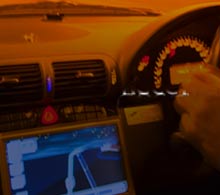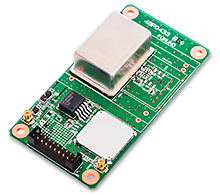Articles for ITS market
Will FCVs (Fuel Cell Vehicles) Become Popular?
~New Movement in Toyota and Honda~
 Cutting model of Toyota's MIRAI at a technical exhibit. Photo by the author.
Cutting model of Toyota's MIRAI at a technical exhibit. Photo by the author.
 Simulated external power supply from MIRAI. Photo by the author
Simulated external power supply from MIRAI. Photo by the author
 A module developed by Toyota to move and store hydrogen (concept). Photo by the author
A module developed by Toyota to move and store hydrogen (concept). Photo by the author
Active EV Shift and FCV trends around the world
When will fuel cell vehicles come into widespread use?
There are probably many people in Japan who have such questions.
In recent automotive news, Toyota revised its plan to "produce 3.5 million EVs globally by 2030 in a single year" at company’s "Briefing on Battery EVs". In addition, Honda and Sony have announced that they will collaborate in EV R&D and production. Apparently, the EV shift has taken precedence and there is little room for fuel cell vehicles.
The basis for the recent shift to EVs is the "European Green Deal" from the European Commission (EC), the executive body of the European Union (EU).
The most recent policy stipulates that "by 2035, virtually 100% of new passenger cars sold in Europe will be EVs (electric vehicles) or FCVs (fuel cell vehicles).
In respect to EVs, Mercedes-Benz, BMW, Volkswagen, and Audi of Germany, center of the European automobile industry, also Volvo of Sweden, and Jaguar of the UK, which has left the EU, are aggressively introducing new EVs to the market in anticipation of the 2035 regulations.
The European Commission has begun tightening regulations on EVs with a view to incorporating ESG investments from stock market with a focus on the environment and social governance. And as a result the European auto industry has been energized to shift to EVs at a rapid pace.
On the other hand, with regard to fuel cell vehicles, despite the fact that they have been incorporated into the 2035 regulatory framework in Europe, European manufacturers seem to be moving slowly at this point.
Also in the U.S., there is CaFCP (California Fuel Cell Partnership). It is one of California's administrative agencies, in which automakers from Europe, the U.S., Japan, and Korea have been jointly participating since the early 2000s.
However, although it is said that Honda-led research and development of fuel cell vehicles is continuing, we have not heard any concrete results announced recently. Furthermore, there has been little recent news on fuel cell vehicles from Ford, which previously participated in CaFCP, or from Chrysler and Dodge, which are part of Stellantis N.V.
Let’s move to fuel cell vehicles in Japan, while Toyota is manufacturing the second generation "MIRAI," Honda has discontinued production of the "FCX Clarity," and Nissan has completely ceased to update any major R&D activities regarding to fuel cell vehicles.
In addition, South Korea's Hyundai, which has returned to the Japanese market after a 13-year absence, is set to introduce the NEXO.
Thus, for the time being, the only fuel cell-equipped passenger cars in Japan are likely to remain MIRAI and NEXO.
With such a limited model lineup of fuel cell vehicles, it is natural that some users may ask, "Will fuel cell vehicles really become popular in the future?"
The Future of Hydrogen Stations
Looking back at the history of fuel cell vehicles, CaFCP mentioned earlier. JHFC in Japan, etc., were active in the early 2000s as demonstration tests were conducted in collaboration with industry, academia, and government. However, the cost of vehicles and hydrogen fuel, as well as the need to develop hydrogen refueling infrastructure, the company was unable to move from the R&D phase to the full-scale mass production phase, and the so-called "valley of death" could not be crossed.
In conjunction with the launch of Toyota's first-generation "MIRAI" in late 2015, the Japanese government designated 2016 as the "First Year of Hydrogen" and took measures to further promote the ENE-FARM for home use, expand mass production of fuel cell vehicles, and build more hydrogen stations.
Six years have passed since then, and the current situation is a mixture of those that have achieved their initial goals and those that are far from achieving them.
For example, let us refer to the document entitled "Subsidy for Hydrogen Station Development Project to Promote Fuel Cell Vehicles" compiled by the Agency for Natural Resources and Energy of the Ministry of Economy, Trade and Industry in March 2021.
The number of hydrogen stations is 162 compared to the 2020 target of 160, barely cleared the target, but the total number of fuel cell vehicles is 5268, a large gap from the 2025 target of 200,000. The 2030 target is set at 900 hydrogen stations and 800,000 vehicles, but it is almost impossible to achieve the target, especially since there are only two vehicle models in mass production.
On the other hand, for commercial use only, the current number of fuel cell buses is 104 compared to the 2030 target of 1,200, and the current number of fuel cell forklifts is 330 compared to the 2030 target of 10,000. Compared to passenger cars, the target is lower so there might be a possibility of achieving it.
Under such environment, Toyota and Honda are developing fuel cell modules to promote the commercial use of fuel cells. And Toyota is participating motorsports that directly feeds hydrogen to an internal combustion engine to promote research and development of hydrogen engine.
In addition, for hydrogen storage modules, which are necessary for transporting hydrogen, Toyota is utilizing the hydrogen tanks used in the MIRAI and has shown four types of different sized concept models depending on the amount of hydrogen stored.
Thus, it is likely that the collaboration with industry, academia, and government will strengthen the commercial usage of fuel cells, which has a higher feasibility.
As for passenger vehicles, due to the shift to EVs, it is likely that the promotion of fuel cell technology will vary considerably in speed from country to country.
Writer introduction

Mr. Kenji Momota Automotive journalist
His major is the world automotive industry and he is also familiar with the energy industry, IT and the aging society problem as the related fields. He acts around the world based in Japan and USA and writes for the general magazines, the technology journals and the automotive related media etc.
He is also commentator of motor race and world's motor show on TV program based on his career of the driver of Indy Racing League and NASCAR. In recent years, he has been covering about a paradigm shift from developed countries to developing countries, the motorized vehicle like EV and the telematics.
FURUNO ITS Journal
Click here for the latest articles after 2022 (in Japanese)2022
- The "realistic" self-driving roadmap shown by the Japanese government and a hands-on report on the latest Subaru EyeSight X
- Will FCVs (Fuel Cell Vehicles) Become Popular? ~New Movement in Toyota and Honda~
- The 'Complete' online sales of new cars start in Japan. Will this new way of buying cars take root?
- Many Firsts! On-Site Report from Tokyo Auto Salon 2022 - The author, who knows what goes on behind the scenes, looks back on 40 years of history. -
2021
- "Moving toward zero traffic fatalities for four-wheeled and two-wheeled vehicles globally in 2050" ~Experience on Honda's latest safety technologies~
- Tsuneishi Shipbuilding's building and DX, an exclusive visit to the main factory
- Japan's Smart City: New Moves toward Practical Use
- When will self-driving buses (service cars) be put to "full-scale" practical use?
- Utilization vehicle data during disasters
- Toyota-led Connected Technology to Transform Commercial Vehicle Business -From light trucks to large trucks and buses-
- Toyota enters the connected car "Personalization" business
- Japanese automakers' carbon-neutral strategies swept up in ESG investment
- Drive experience of the latest autonomous vehicle models and advanced driving support systems
- Will carbon neutrality accelerate the trend to strengthen LCA (Life Cycle Assessment)?
- Semiconductor shortage exposes realities of the automotive industry
- Online Autonomous Driving Contest Enhancing development of Human Resources
2020
- What happens to CASE when gas cars are banned in Japan?
- When will Flying Cars be launched?
- Expectation vs. reality:Autonomous Driving in Japan
- V2X, Becoming increasingly important in autonomous driving
- Technology of Subaru “EyeSight X”
- Lifestyle-oriented French cars gain popularity in Japan
- Human-oriented smart cities are wanted
- MaaS and CASE, how would automotive industry change after COVID-19?
- The beginning of virtualization era, triggered by COVID-19
- Trend of EV shift and consumer demands
- TOYOTA Press conference about ADAS - Releasing algorithm for "sudden acceleration suppression during attempted sudden acceleration" free of charge -
- The Japanese automotive industry in 2020 - 3 turning points -
- "Using a smartphone while driving" and "Level 3 automated driving"
2019
- Motor show business model is at a turning point - Tokyo Motor Show Report -
- Commercialization and monetization of MaaS - ITS World Congress Singapore Report -
- Android Automotive pays attention to V2X - Report from the Frankfurt Motor Show 2019 in Germany -
- Automobile Distribution Revolution and DCM (Data Communication Module)
- Connected business potential and newly proposed "eMaaS" by Honda
- 5G services for practical use are multiplying
- Connectivity technologies attracting attention due to frequent traffic accidents
- Shanghai Motor Show report -SUV, EV, Automated car & 5G-
- Drone Business roadmap and updates to Michibiki (Quasi-Zenith Satellite System)
- MaaS (Mobility as a Service) "town development." Full-scale promotion for a national project
- CES organizer states "Data Period in 2020s." Transformation of the Automotive Industry in CES, US "-CES2019 Report-"
- "Return to Origin" directed towards the age of change, automatic operation and connectivity
2018
- New proposal for Private Car Automated Driving Level and other Hot 5G Technology Topics
- Standardized EV charging infrastructure concerns in Europe, US, Japan and China - Kobe EVS 31 field report -
- Touring a pure car carrier and a test drive of the latest hybrid car
- Planning stage products are exhibited at the newly established visualized mobility service "TOYOTA MOBILITY SHOWROOM".
- Potential “Community Car-share” program promoted by local residents
- CES Asia Report 2108
- Companies attempt new Vehicle-to-Infrastructure communications, including traffic volume measurements and vehicle positioning. -ITS Asia Pacific Forum in Fukuoka-
- Geneva show in Switzerland. Flying cars and MaaS (Mobility as a Service) were hot topics.
- EV (Electric Vehicle) proposals by country
- MaaS competition through service mobilization, M & A and technical field collaboration is accelerating. - The CES 2018 Report -
2017
- Big data’s initiative and fight for the automotive industry. Cooperation among companies becomes increasingly important.
- Connected car and road-to-vehicle communication automatic operation
- ETC (Electronic Toll Collection) and ETC2.0. Current situation and projected future
- Rapid development of sharing economy
- Germany is first to recognize level 3 automated driving
- ITS EU 2017 Field Reports -Automatic Operation and the eCall-
- From Infotainment to ITS, the competitive area is spreading in the car big data industry.
- GTC (GPU Technology Conference) Report and the de facto standardization of AI (artificial intelligence)
- Renesas' new challenge! "e-AI Solution" and "Renesas Autonomy"
- The Automobile industry is shifting from a manufacturing industry to a service industry.
- The movement toward accident countermeasures for aging drivers in Japan
- Fusion of ride sharing and fully automated driving is advancing in the USA.
2016
- Overview of the Quasi-Zenith Satellite System (QZSS) and advancements toward full-scale practical use including the Tokyo Olympic Games - G-space EXPO 2016 report-
- Japan’s automated driving project "SIP-adus" will be a large demonstration experiment.
- The International Home Care & Rehabilitation Exhibition. There were many car manufactures with exhibits booths at this show.
- Japanese car manufacturers starting to concentrate on strengthening the ADAS system
- A new movement of legislation for autonomous cars
- Cyber Security and “AGL”, the new OS for automotive are hot topics in the connected car industry
- “High precision 3D map” the key future of autonomous car and pedestrian dead reckoning
- Chinese “BAT” is accelerating their business in the EV (Electric Vehicle) market
- Tesla's original connection to Taiwan and the new transportation system technologies.
- "The main topic" of the Geneva Motor Show was how to strengthen "pedestrian protection"
- The probe data business is getting more competitive
- Reporting directly from the 2016 CES show "Data services will soon become the main revenue source of automotive industry"
2015
- Do the automated driving systems need the GNSS (Global Navigation Satellite System) ?
- ETC Version 2.0 is coming soon. A new service was announced at the Tokyo Motor Show and the possibility that is could be used as a device for older drivers.
- "Connected Horizon" and "eHorizon". Germany's leading parts supplier accelerates strengthening of "Big Data" for business



 Honda's fuel cell module for commercial use. Photo by the author.
Honda's fuel cell module for commercial use. Photo by the author. Hydrogen filling machine on display. Photo by the author.
Hydrogen filling machine on display. Photo by the author. GPS/GNSS Receiver&Chips and Modules (positioning and timing)
GPS/GNSS Receiver&Chips and Modules (positioning and timing)